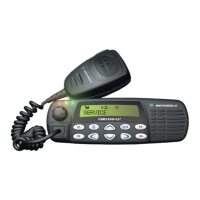2-18 Theory of Operation
2.4 200 M
Hz
Receiver Front-End
The 200 MHz receiver design covers the frequency range
of
217 to 222 MHz and is separated into
two blocks, the front end and the back end. The overall block diagram
of
the receiver is shown
in
Figure 2-11. Detailed descriptions of these stages are contained
in
the paragraphs that follow.
RX from
Antenna Switch
--~
Antenna
Filter
First
LO
RF
Amp
from Synthesizer
--
......
1
RF
Amp Crystal
IF
Filter 1st Mixer Filter Amp
Cer
Fltr Cer Fltr
Ceramic
Resonator
r---
Recovered
Audi
o--1
Demodulator
RSSI..
I
Figure 2-7. 200 MHz Receiver Block Diagram
2.4.1 Receiver Front
End
=
T
The received signal from the antenna is routed through the harmonic filter and antenna switch and
applied to the antenna filter, consisting
of
L0320-22 and C3040-47. This fixed-tuned 3-pole
bandpass filter is configured to provide steeper attenuation above the passband for improved
spurious rejection when high-side first injection is used. The output
of
this filter
is
coupled to RF
amplifier
03002.
Diode CR3003 protects the RF amplifier
by
limiting excessive
RF
levels. Current
mirror
03003
maintains constant current operation
of
the
RF
amp vs. device and temperature
variations, for optimum dynamic range and noise figure.
The output
of
the
RF
amplifier is applied to the RF amp filter comprised
of
L3023-4, L3041, C3052-
7 and C3359, also a fixed-tuned 3-pole bandpass filter configured to provide steeper high-side
attenuation. The antenna filter and
RF
amp filter have a combined 3 dB bandwidth
of
24 MHz and
utilize 2% inductors and 1% capacitors for accurate and repeatable passband response.
The output
of
the RF amp filter
is
routed through a switchable local-distance attenuator consisting
of
R3099, D3090,
03090
and associated components. Normally
03090
and D3090 are on and the
receiver sensitivity
is
at maximum. When
03090
and D3090 are off, the series resistor R3099
reduces receiver sensitivity to minimize intermodulation when operating
in
the presence strong
undesired signals. The output
of
the local-distance attenuator
is
connected to the passive double-
balanced mixer consisting
of
components T3001, T3002, and CR3001. High-side injection from the
frequency synthesizer
is
lowpass filtered by C3073-6, C3081, and L3027-8 to remove second
harmonic energy which may degrade half-IF spurious rejection performance, and applied to T3002
_)
at a level
of
+19 dBm.

